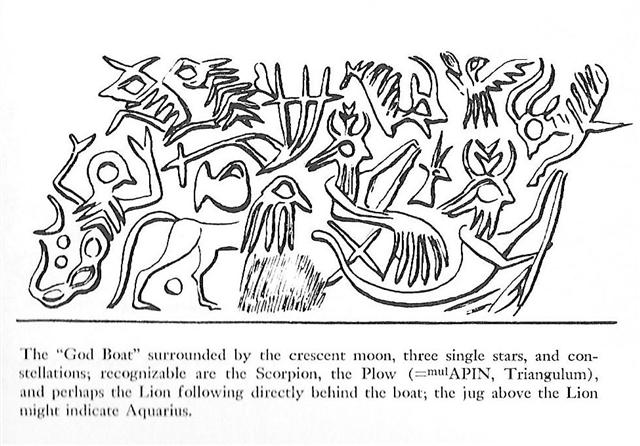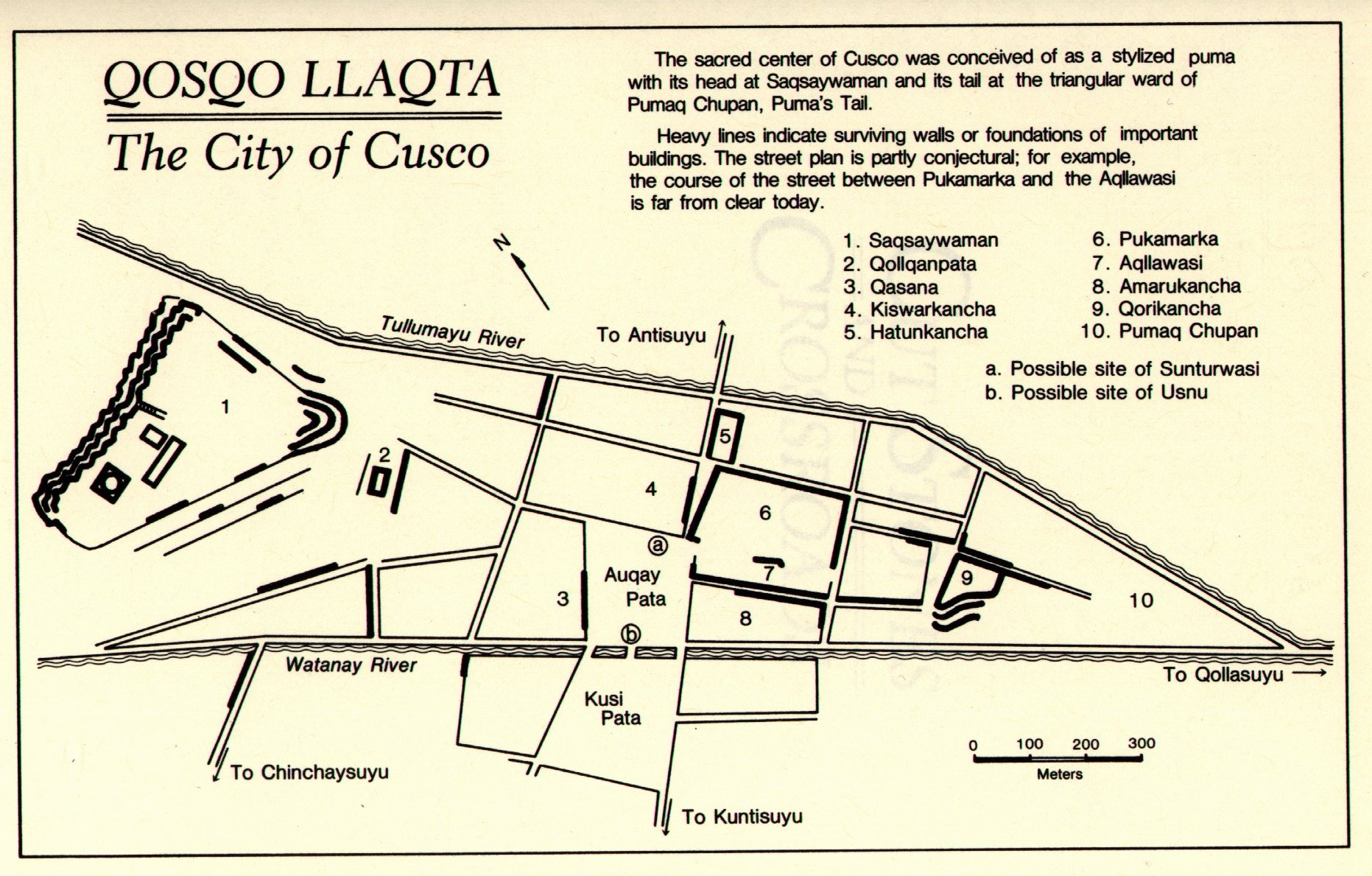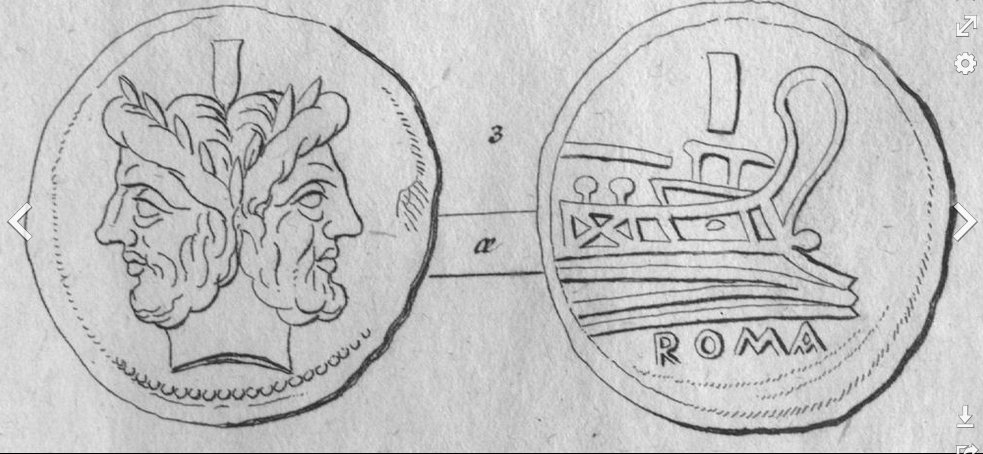The
Rei
glyphs
occur
only
on
side
a
(the
front
side)
of
the
G
tablet.
If
such
referred
to
stars
in
Argo
Navis
then we
could
predict
that
also
the
3rd
Rei
in
the
text
would
be
at
some
star
in
the
sunken
ship:
 |
 |
 |
 |
 |
19 |
| Ga1-30 |
Ga2-1 |
Ga2-2 |
Ga2-3 (33) |
Ga2-4 |
| ●APRIL 9 (*19) |
10 (100) |
11 |
12 |
13 |
| APRIL 20 (*30) |
21 (111) |
22 |
23 |
24 |
| Furud (94.9) |
Well-22 / Arkū-sha-pu-u-mash-mashu-9 |
no star listed (96) |
β Monocerotis, ν Gemini (97.0) |
no star listed (98) |
| δ Columbae (95.2), TEJAT POSTERIOR, Mirzam (95.4), CANOPUS (95.6), ε Monocerotis (95.7), ψ1 Aurigae (95.9) |
| June 23 |
ST JOHN'S EVE |
25 |
26 (177) |
27 |
| ºJune 19 |
20 (*91) |
SOLSTICE |
22 (173) |
23 |
| 'May 27 |
28 (*68) |
29 |
30 (150) |
31 |
| "May 13 |
14 (*54) |
15 |
16 (136) |
17 |
| NAKSHATRA DATES: |
| ●OCTOBER 9 |
10 |
11 (*204) |
12 (285) |
13 |
| OCTOBER 20 |
21 |
22 (295) |
23 (*216) |
24 |
| Purva Ashadha-20 |
Kaus Borealis (279.3) |
ν Pavonis (280.4), κ Cor. Austr. (280.9) |
Abhijit-22 |
| KAUS MEDIUS, κ Lyrae (277.5), Tung Hae (277.7) |
φ Oct. (278.1), KAUS AUSTRALIS (278.3), ξ Pavonis (278.4), Al Athfar (278.6) |
θ Cor. Austr. (281.0), VEGA (281.8) |
| December 23 |
CHRISTMAS EVE |
25 |
26 (360) |
27 |
| ºDec 19 (*273) |
20 (354 = 12 * 29½) |
SOLSTICE |
22 |
23 |
| 'Nov 26 (*250) |
27 |
28 |
29 (333) |
30 |
| "Nov 12 (*236) |
13 |
14 |
15 |
16 (320) |
 |
 |
 |
 |
 |
 |
 |
| Ga2-24 |
Ga2-25 |
Ga2-26 |
Ga2-27 |
Ga2-28 |
Ga2-29 |
Ga3-1 (60) |
| ●MAY 3 |
4 |
5 (125) |
6 (*46) |
7 |
8 |
9 |
| MAY 14 |
15 |
16 (136) |
17 (*57) |
18 |
19 |
20 |
| φ Gemini (118.4) |
Drus (119.9) |
ω Cancri (120.2) |
8h (121.7) |
ρ Puppis (122.0), Heap of Fuel (122.1), ζ Monocerotis (122.3), ψ Cancri (122.6), Regor (122.7) |
Tegmine (123.3) |
Al Tarf (124.3)
Ras Algethi
|
| χ Gemini (121.0), NAOS (121.3) |
| July 17 |
18 |
19 (200) |
20 |
21 |
22 |
23 |
| ºJuly 13 |
14 |
15 |
16 |
17 (*118) |
18 |
19 (200) |
| 'June 20 (*91) |
SOLSTICE |
22 |
23 |
ST JOHN'S EVE |
25 |
26 (177 = 6 * 29½) |
| "June 6 (314 / 2) |
7 |
8 |
9 (*80) |
10 |
11 |
12 |
| NAKSHATRA DATES: |
| ●NOVEMBER 2 |
3 |
4 (308) |
5 (*229) |
6 |
7 |
8 |
| NOVEMBER 13 |
14 (318) |
15 |
16 (*240) |
17 |
18 (322) |
19 |
| ι Sagittarii (301.2), Terebellum, ξ Aquilae (301.3), Alshain (301.6), φ Aquilae (301.8) |
ε Pavonis, θ Sagittarii (302.3), γ Sagittae (302.5), μ Pavonis (302.7) |
τ Aquilae (303.8) |
20h (304.4) |
Shang Wei (305.2), θ Sagittae (305.4), Tseen Foo (305.6), ξ Capricorni (305.8) |
Tso Ke (306.3) |
Gredi (307.2), σ Capricorni (307.5), Alshat (307.9) |
| η Sagittae (304.2), δ Pavonis (304.4) |
| January 16 |
17 |
18 (383) |
19 |
20 |
21 |
22 |
| ºJanuary 12 |
13 (378) |
14 |
15 (*300) |
16 |
17 |
18 |
| 'December 20 |
SOLSTICE |
22 |
23 (*277) |
CHRISTMAS EVE |
25 |
26 |
| "December 6 |
7 |
8 |
9 |
10 (*264) |
11 |
12 (346) |
Modern astronomers have cut up Argo Navis into parts, making it difficult to perceive the whole. But the ancient Babylonians saw it clearly:

The head of the Lion was in the center, under the Plow and above what looks like an indistinct 'primordial heap of mud'. And water was poured upon the hind quarters of Leo, something which evidently never was forgotten:


Situla (κ Aquarii, at the mouth of the water pitcher) was 175 (= 350 / 2) days before Regulus (not 183 days).

There were 190 days from Regulus (the little king) to Situla. 365 - 175 = 190 = 182 + 8. These 8 days could possibly have been interpreted as dark nights preceding the morning of a new year.
| 8 |
α Leonis |
232 |
August 20 |
| 6 |
| p Carinae |
239 |
August 27 |
| 182 |
| Situla |
κ Aquarii |
57 |
February 26 |
| 174 |
 |
 |
 |
 |
 |
 |
 |
 |
| Ga4-1 (84) |
Ga4-2 |
Ga4-3 |
Ga4-4 |
Ga4-5 |
Ga4-6 |
Ga4-7 |
Ga4-8 |
| υ¹ Hydrae (148.4), Ras Elaset Borealis (148.7) |
Tseen Ke (149.9) |
ν Leonis (150.1), π Leonis (150.6) |
υ² Hydrae (151.8) |
Al Jabhah-8 / Maghā-10 / Sharru-15 |
λ Hydrae (153.2) |
Adhafera, Tania Borealis, Simiram (154.7) |
Algieba, q Carinae (155.5) |
| 10h (152.2) |
| AL JABHAH (152.4), REGULUS (152.7) |
| August 16 |
17 |
18 |
19 |
20 (232) |
21 |
22 |
23 |
 |
 |
 |
 |
 |
 |
 |
|
Ga4-9 (92) |
Ga4-10 |
Ga4-11 |
Ga4-12 |
Ga4-13 |
Ga4-14 |
Ga4-15 |
|
Tania Australis (156.0),
Ghost of Jupiter (156.8) |
Extended Net-26b |
Maru-sha-arkat-Sharru-16 |
p Carinae (159.3) |
φ Hydrae (160.3) |
no star listed (161) |
Vathorz Posterior (162.1),
Peregrini, η Carinae (162.6) |
|
μ HYDRAE
(157.1) |
SHIR
(158.9) |
|
August 24 |
25 |
26 |
27 |
28 (240) |
29 |
30 |
However, the G text seems more to emphasize 'the 4th Son behind the Sun' (Maru-sha-arkat-Sharru), arriving 6 days after Regulus and at Shir (ρ Leonis). The glyph is of the type haka-ua (making rain). The excessive heat of high summer will eventually produce much rain. The 4th quarter is the rainy season (winter) and the 4th Son could therefore be an allusion to water.
The water jug above the tail of the Lion is not vertically oriented as when on top of Janus:

Possibly the reason was that it served as a sign similar to how the outline of Cassiopeia could have been used to indicate not only up and down but also east (Σ):
| Egyptian tusk |
 |
Phoenician shin |
 |
Greek sigma |
Σ (σ, ς) |
|
Wikipedia: Shin (also spelled Šin (šīn) or Sheen) literally means 'teeth, 'press', and 'sharp' ...
The symbol Σ is currently used as an expression for 'sum'. The Phoenician shin is oriented in another way, similar to how Cassiopeia is read in the night when in a low position - as Celestial W when below the pole, in contrast to the Celestial M when above it.
Greek sigma therefore resembles Cassiopeia in between, when she was in the west at the time when the Sun was rising in the east.

|
|




















.jpg)

